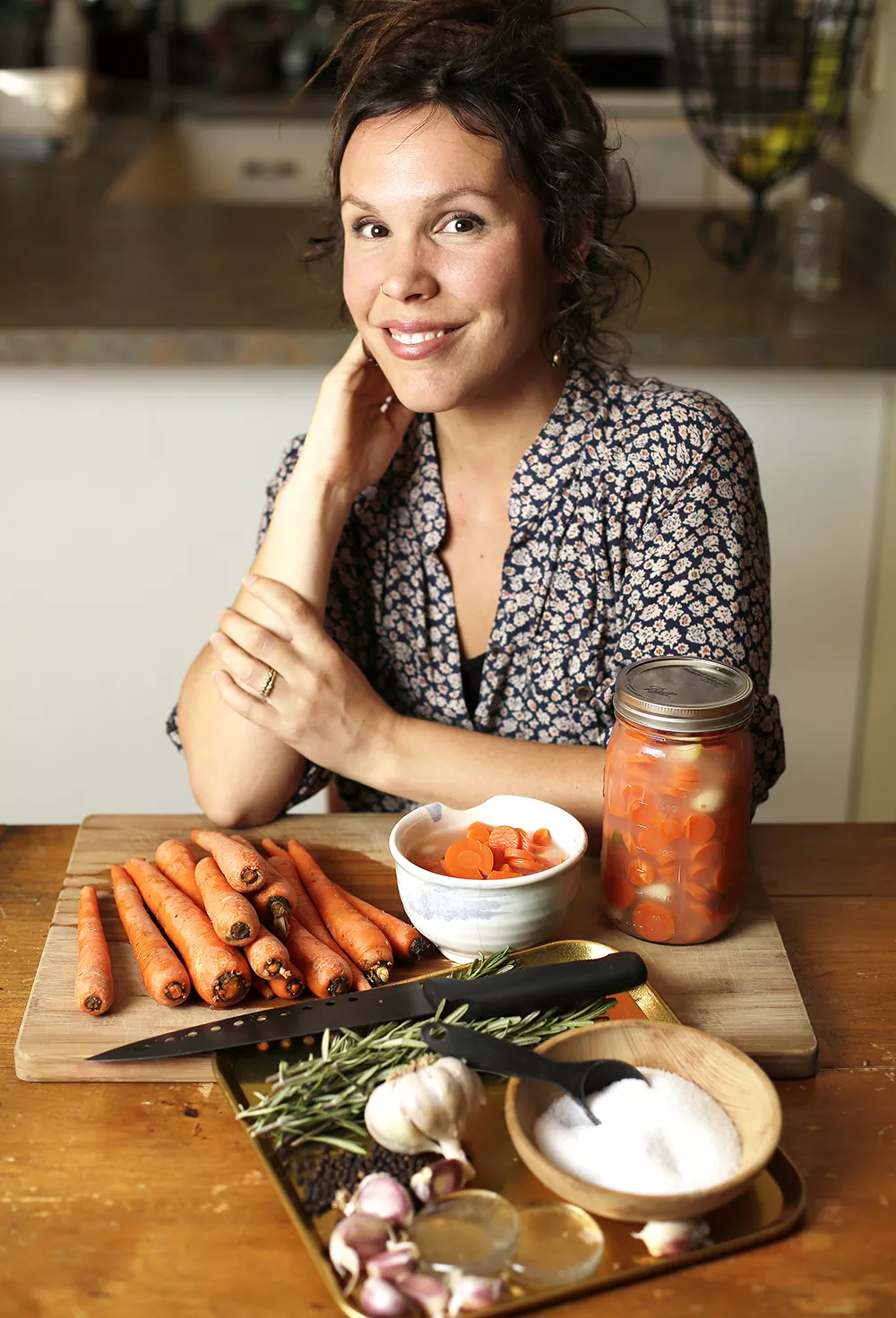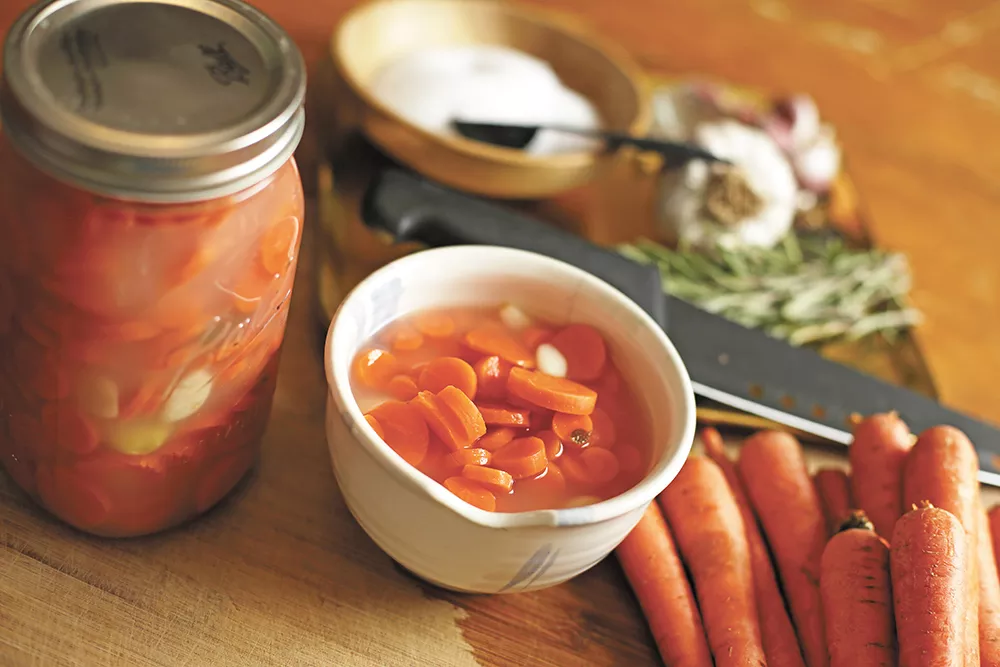Fermentation is nothing new; it's been employed in food and beverage production for centuries — used to make bread and cheese, preserve fruits and vegetables, and craft wine and beer, it's an art form dating back 9,000 years. What is new, though, is the focus on fermentation for its health benefits, especially aiding in digestion.
"The human GI tract contains over 70 percent of the body's entire immune system," says Natalie Colla, a licensed, registered dietitian with Panhandle Health District, "and when this becomes compromised, all kinds of chronic diseases and infections can occur."
A healthy gut, she says, can "play a role in regulating obesity, diabetes, heart disease, allergies and more."
We know the benefits of consuming fiber-rich "prebiotic" foods, especially whole grains, legumes and certain vegetables. But our digestive systems can also benefit from probiotics: living bacteria and yeasts abundant in fermented foods like yogurt, miso (cultured soybean) and kombucha.
Cole Ina Merlo Griffin of Coeur d'Alene discovered fermentation four years ago as a new mother in search of a local Community Supported Agriculture program. She met a farmer, also a young mother, who introduced her to fermenting as a way of preserving the harvest. Griffin was so intrigued with the farmer's fermented pickles, she dove into research and experimentation.
Griffin has since taught numerous classes, including through Pilgrim's Market, which carries her Cultured Mama line of fermented sauerkrauts, veggies and cashew-based probiotic dips.
When fermenting, it's important to know what fermentation is and is not. Both pickling and fermenting preserve food in liquid, resulting in a tart-tangy flavor. Pickling uses acid, such as vinegar, to kill spoilage-causing and dangerous bacteria; heat does the job in home canning. Both processes also kill good bacteria, found to be increasingly vital to gut health.
Chemically speaking, fermentation is the metabolic conversion of carbohydrates — sugar in fruit, for example — into either ethanol or lactic acid.
We might associate ethanol with biofuel, but it's really an alcoholic by-product, such as when yeast "eats" sugar in making wine, bread and kombucha.
In lacto-fermentation, lactobacillus bacteria convert starches and sugars into lactic acid, essentially pre-digesting them. (That's why some lactose-intolerant people can eat yogurt, but not milk.) The process lends tang to dairy products like buttermilk, sour cream, some cheeses, and kefir, a cultured milk beverage originating in the Russo-Georgian Caucasus region. It also turns vegetables such as cabbage into sauerkraut or Korean kimchi.
In her classes, such as Inland Northwest Food Network's recent Seasonal Kitchen class, Griffin covers technique and nutrition. For example, fermented foods can be denser in vitamins, especially B and C, than their raw counterparts. She also talks about materials like the sea salt she favors for creating her essential brine, because processed salt isn't suitable for fermenting.
But what about food safety?
"Properly fermented vegetables can be safer than raw," says Anna Kestell, Washington State University Extension's Food Preservation/Safety Education Coordinator, echoing the oft-quoted words of United States Department of Agriculture microbiologist Fred Breidt. The issue isn't fermentation, she says, but rather storing the food properly. Fermented foods stored in a refrigerator or a 40-degree Fahrenheit root cellar should last long enough to make it through many meals.
"And that's why it's been around since the dawn of time," says Kestell. ♦
Probiotic-Rich Garlic Carrot Coins
Coeur d'Alene mom Cole Ina's two young children enjoy the Happy Bellies Pea Salad she makes with these carrot coins (pictured above), which will brighten up the flavor of any salad or sandwich and add gut-friendly bacteria.
Supplies
Clean, wide-mouth quart Mason jar with lid
Coffee filter, tea towel or cloth napkin,
rubber band, marker
Weight: Empty jam jar or glass/ceramic weight (available at kitchen specialty stores)
Ingredients
2 tablespoons sea salt (do not use processed or iodized salt)
Large handful organic carrots, washed but not scrubbed or peeled
1 to 4 garlic cloves, peeled
Outer leaf of cabbage (grape leaf or raspberry leaf also would work)
Optional seasonings: chili flakes, dill, rosemary
Directions:
1. Wash jar and weight in warm, soapy water (do not use scented or antimicrobial soap), rinse well, and let air dry.
2. Put garlic in bottom of the wide mouth jar. Add other seasonings as desired.
3. Slice carrots into quarter-inch-thick coins, excluding ends.
4. Fill jar to the "shoulder" with sliced carrots, packing down gently.
5. Rinse outer cabbage leaf in cold running water and "tuck" cabbage leaf into jar. This covers and secures the carrots from floating up out of your brine where they'd be exposed to air.
6. To make 2 percent brine, dissolve sea salt in a little bit of warm water, then add cool water to make 1 quart.
7. Pour half of your brine into the jar with the carrots and garlic, until everything is covered. Keep the remaining brine for refilling brine level as needed throughout fermentation.
8. Place weight onto the cabbage and push down (if using empty jam jar, fill with brine to weigh it down).
9. Cover jar with a coffee filter, tea towel or cloth napkin and secure with rubber band. Record the date (on the coffee filter or the jar).
10. Put fermentation jar in area where you can easily check on it, yet out of direct sunlight.
11. Check brine level, adding more as needed. None of the plant material should be exposed to air. You should see bubbles forming at the top of the jar.
12. After five days, use clean utensil to check whether carrot is tangy enough for you. If not, carefully repack carrots, cabbage and weight as you did before.
13. Once fermented, put lid on jar and store in refrigerator.
Happy Bellies Pea Salad
Ingredients
4 cups peas (defrost if using frozen peas)
2 cups fermented carrot coins, chopped
Small handful of mint, julienned
Half a small red onion, sliced very thin
¼ cup avocado mayonnaise (or regular mayo)
¼ cup brine from carrot coins
1 to 2 cloves of garlic from fermented carrot coins, pressed
Black pepper, to taste
Directions:
Mix peas, chopped carrots, cut mint and sliced onions in large bowl
Mix mayo, brine, pressed garlic and black pepper in a small bowl
Combine and serve as is or with salad greens. ♦





















